This adriaticnature article is the last one that deals with the inhabitants of the Adriatic Sea that represent the most numerous fish order, the Perciformes order, as well as fish, which used to be included in it until recently. However, there will be another article about ex-Perciformes (but today they are already “ex”). So let’s start with the fish of the Trachiniformes order.

(Stargazer. Photo © siladen.com)
Until recently, they were certain to include the Trachinoidei suborder in the Perciformes order, but nowadays these fish are considered to be representatives of the separate Trachiniformes order. The order comprises 12 families, three of which inhabit the Adriatic Sea, including Ammodytidae, Trachinidae and Uranoscopidae.
The sand lance or sandlance (Ammodytidae) family comprises more than 30 fish species of 7 genera. Ammodytidae are most widely spread in the northern part of the Pacific and Atlantic oceans. However, they are found in the salt waters almost all over the world. The fish of the family don’t have pelvic fins and a swim bladder. Their bodies are elongated, thus, slightly resembling an eel. These are medium-sized sea inhabitants – the maximum length is 30 centimeters. Many species bury themselves into sand for wintering and at low sea, they feed on zooplankton.
Although ichthyologists have recorded previously unknown deep-sea species in recent years, representatives of Ammodytidae are more often nearshore inhabitants. Juvenile and adult Ammodytidae specimens are an important nutritional component for many predatory fish and seabirds. Some species of the family are a popular fishing buzz in many European and North American countries. Although the family is called “sand lance”, some species are united under the name of “sand eel”, which is familiar to many anglers due to the names of artificial lures that imitate the shape of these fish. Only one representative of the family is found in the Adriatic Sea:
Mediterranean sand eel (Gymnammodytes cicerelus).

(Mediterranean sand eel. Photo © europeix.cat)
It dwells near a sandy and pebble bottom. It is a schooling species. The maximum recorded length is 17 cm, specimens up to 12.5 cm long are more common. It feeds on zooplankton. It is a permanent infrequent inhabitant of the Adriatic Sea.
The weevers or weeverfish (Trachinidae) family is known to most people who are fond of fishing in the South European and in other seas. The family comprises 9 notorious species of 2 genera. The spines of the first dorsal fin and the spines of the gill covers of Trachinidae contain venom. The venom getting into the blood of a human being has unpleasant consequences. adriaticnature described in detail the consequences of encountering these inhabitants in the article “Dangerous inhabitants of the Adriatic Sea. Fish” and what should be done if people were in contact with them. Keep in mind that the venom contained in the spines is thermolabile, i.e. it disintegrates at high temperatures.
Trachinidae are ambush predators that attack their prey, having previously buried themselves into the sandy bottom, and are almost invisible to their victims. They feed on benthic organisms and medium-sized fish. Four out of nine species of the family are found in the Adriatic Sea:
Lesser weever (Echiichthys vipera).
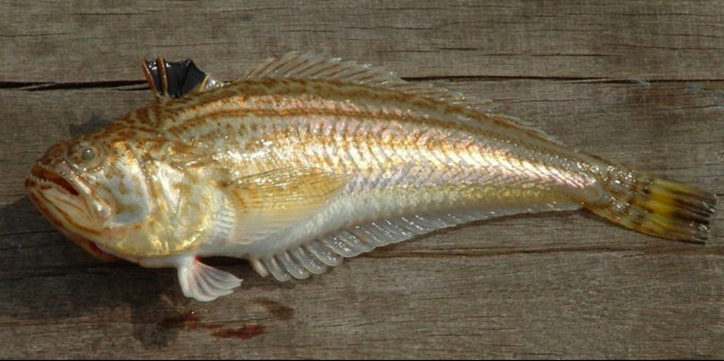
(Lesser weever. Photo by © Richard “Tiny” Daw. getswellsoon.com)
It inhabits the depth of 1-150 meters, sinks to depths in winter. It dwells near a sandy, silty and pebble bottom. The maximum recorded length is 15 cm, specimens up to 10 cm long are more common. It feeds on worms, crustaceans, mollusks, and small fish. It is a permanent inhabitant of the Adriatic Sea.
Spotted weever (Trachinus araneus).

(Spotted weever. Photo by © Stefano Guerrieri. naturamediterraneo.com)
It inhabits the depth of 1-100 meters. It dwells near a sandy bottom around underwater vegetation and separately lying stones. The maximum recorded length is 45 cm, specimens up to 30 cm long are more common. It feeds on crustaceans and small fish. It is a permanent inhabitant of the Adriatic Sea, it is more common in its southern part.
Greater weever (Trachinus draco).
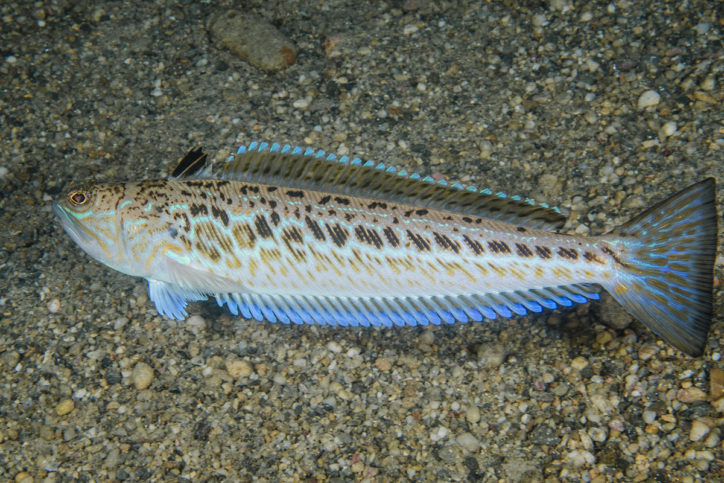
(Greater weever. Photo © ligurianautica.com)
It inhabits the depth of 1-150 meters, usually 1-30 meters. It dwells near a sandy, silty and pebble bottom. The maximum recorded length is 53 cm, specimens up to 25 cm long are more common. The maximum weight is 1.9 kilograms. It feeds on invertebrates and fish. It is a permanent inhabitant of the Adriatic Sea.
Starry weever (Trachinus radiatus).
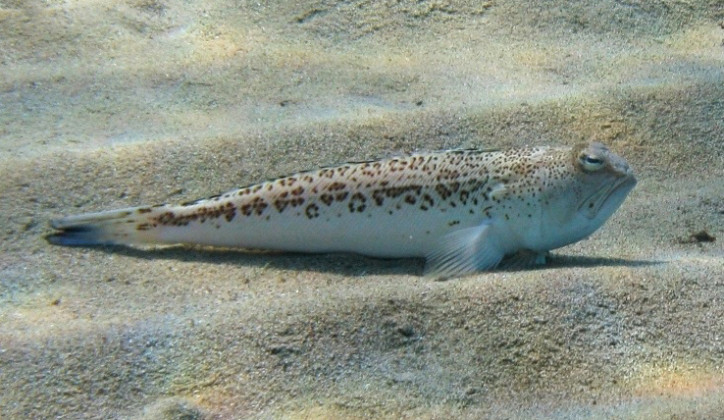
(Starry weever. Photo by © Roberto Pillon. naturamediterraneo.com)
It inhabits the depth It inhabits a depth of up to 150 meters, usually 30-60 meters. It dwells near a sandy and silty bottom. The maximum recorded length is 50 cm, specimens up to 25 cm long are more common. It feeds on invertebrates and fish. It is a permanent inhabitant of the Adriatic Sea.
The stargazers (Uranoscopidae) family comprises 53 fish species that inhabit the Atlantic, Pacific, and Indian oceans. The largest fish of the family is a giant stargazer (Kathetostoma giganteum), which inhabits the waters near the shores of New Zealand. It can be up to 90 centimeters long. Uranoscopidae have one venomous spine above each pectoral fin. The venom is thermolabile, like that of weevers.
The family got its name due to the fact that the eyes of the fish are located close to each other. It creates the illusion that Uranoscopidae are staring at the sky and waiting for the prey, buried in the sand with only their heads being barely visible.
The ability to generate electricity is an interesting peculiarity of a common stargazer. However, the discharges are too weak to harm humans, as well as their potential prey, and fish are not capable of electroreception. Therefore, the purpose of the electric organ of stargazers is still not clear to science.
One representative of the family is found in the Adriatic Sea:
Stargazer (Uranoscopus scaber).

(Stargazer. Photo by © Roberto Pillon. marinespecies.org)
It inhabits the depth of 15-400 meters. It dwells near a sandy and silty bottom. The maximum recorded length is 40 cm, specimens up to 22 cm long are more common. The maximum weight is 940 grams. It feeds on worms, mollusks, and small fish. It is a permanent inhabitant of the Adriatic Sea.
The Callionymoidei suborder of the Perciformes order comprises more than 210 fish species of two families. In recent years, scientists have been discussing the possibility of considering Callionymoidei as the separate Callionymiformes order, but a final decision on this issue hasn’t been made yet.
Callionymoidei are small benthic inhabitants of the seas. The largest representative of the suborder, a longtail dragonet (Callionymus gardineri), inhabiting the waters of the western Indian Ocean, can be 32 centimeters long. The way they move is their peculiar feature. The fish mainly move along the bottom with the help of large pectoral fins. 6 species of the dragonets (Callionymidae) family inhabit the Adriatic Sea:
Banded dragonet (Callionymus fasciatus).
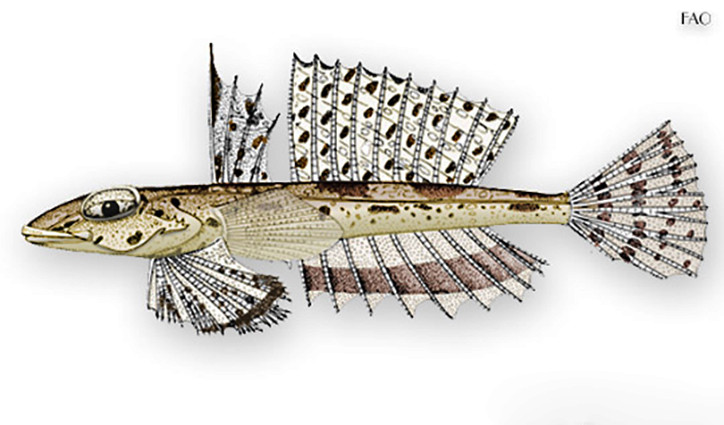
(Banded dragonet. Picture by © colapisci.it)
It inhabits a depth of 20 meters and more. It dwells near a sandy bottom. The maximum recorded length is 12 cm. It feeds on small benthic invertebrates. It is a rare species. It has been found in the Adriatic Sea several times.
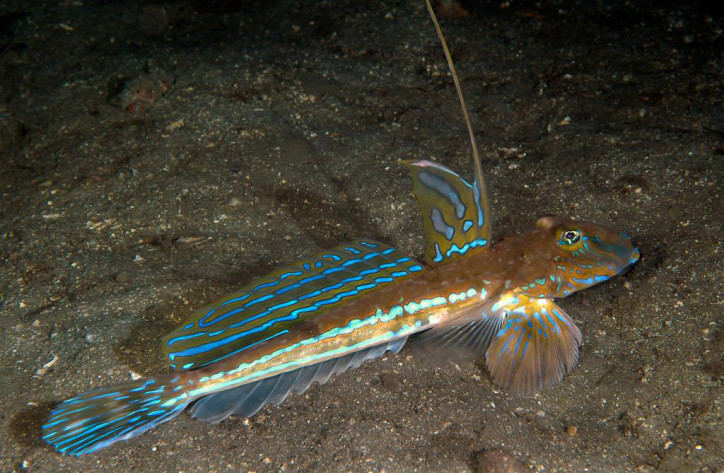
(Dragonet. Photo by © Erling Svensen. suldal.kommune.no)
It inhabits the depth of 5-430 meters, usually 5-30 meters. It dwells near a sandy and silty bottom. The maximum recorded length is 30 cm, specimens up to 15 cm long are more common. It feeds on small benthic invertebrates. It is a permanent rare inhabitant of the southern part of the Adriatic Sea.
Spotted dragonet (Callionymus maculatus).
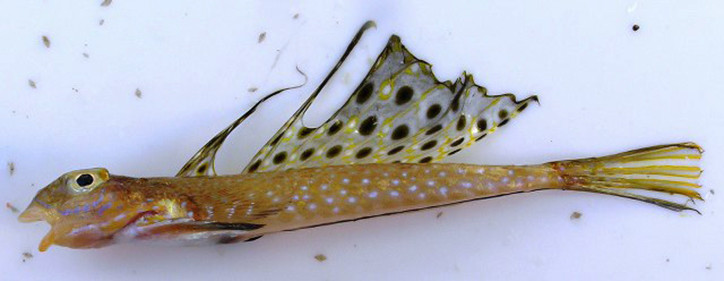
(Spotted dragonet. Photo by © Pedro Lopes Cunha. fishbase.org)
It inhabits the depth of 45-650 meters. The maximum recorded length is 16 cm, specimens up to 13 cm long are more common. It feeds on small benthic invertebrates. It is a permanent inhabitant of the Adriatic Sea.
Sailfin dragonet (Callionymus pusillus).
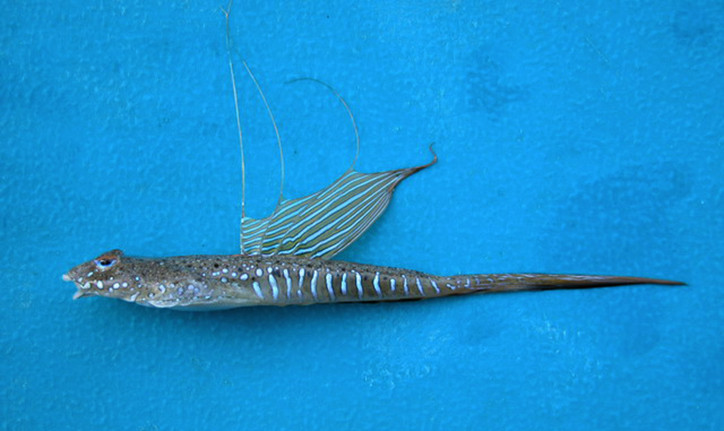
(Sailfin dragonet. Photo by © Sencer Akalýn. fishbase.org)
It inhabits shallow water but can sink to a depth of 100 meters. It dwells near a sandy bottom. The maximum recorded length is 14 cm, specimens up to 10 cm long are more common. It feeds on small benthic invertebrates. It is a permanent inhabitant of the Adriatic Sea.
Risso’s dragonet (Callionymus risso).

(Risso’s dragonet. Photo by © Roberto Pillon. fishbase.org)
It inhabits the depth of 15-150 meters. It dwells near a sandy bottom. The maximum recorded length is 11 cm, specimens up to 5 cm long are more common. It feeds on small benthic invertebrates. It is a permanent inhabitant of the Adriatic Sea.
Phaeton dragonet (Synchiropus phaeton).

(Phaeton dragonet. Photo by © Jo Langeneck. commons.wikimedia.org)
It inhabits the depth of 80-850 meters. It dwells near a sandy and silty bottom. The maximum recorded length is 12 cm, specimens up to 8 cm long are more common. It feeds on small benthic invertebrates. It is a rare inhabitant of the southern part of the Adriatic Sea.
Representatives of the Zoarcoidei suborder of the Perciformes order inhabit mainly the northern regions of the Pacific and Atlantic oceans. The suborder comprises more than 400 fish species of 9 families. The largest species are fish of the Anarhichadidae family, inhabiting the cold and temperate waters of the seas of the Northern hemisphere. The spotted wolffish (Anarhichas minor) can weigh up to 28 kilograms.
The eelpout (Zoarcidae) family comprises more than 230 fish species of the suborder, inhabiting the sea waters from the Arctic to the Antarctic. The ocean pout (Zoarces americanus) is the largest fish of the family. It is a benthic fish, which is widely spread in the northwestern Atlantic Ocean. It can be up to 1.1 meters long. Only one representative of the Zoarcidae family and the Zoarcoidei suborder is found in the Adriatic Sea:
Atlantic soft pout (Melanostigma atlanticum).
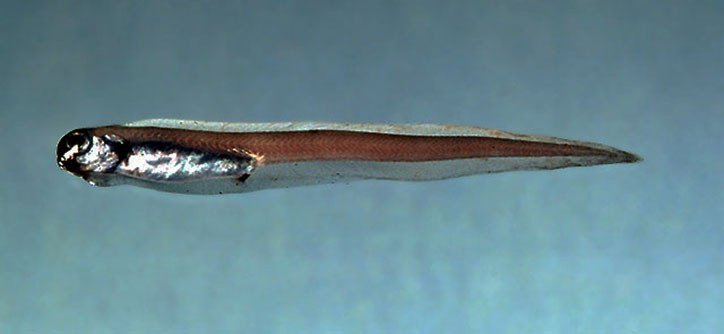
(Atlantic soft pout. Photo by © Don Flescher. fishbase.org)
It inhabits the depth of 400-1853 meters. The maximum recorded length is 15 cm. It feeds on zooplankton. It is a rare inhabitant of the Adriatic. It was registered a couple of times in its southern part.
The Acanthuroidei suborder of the Perciformes order comprises about 135 fish species of 6 families. The inhabitants of coral reefs of the Acanthurus genus are probably the most famous.
Representatives of two families (Luvaridae and Siganidae) have been found several times in the Adriatic Sea. The Luvaridae family comprises only one species:
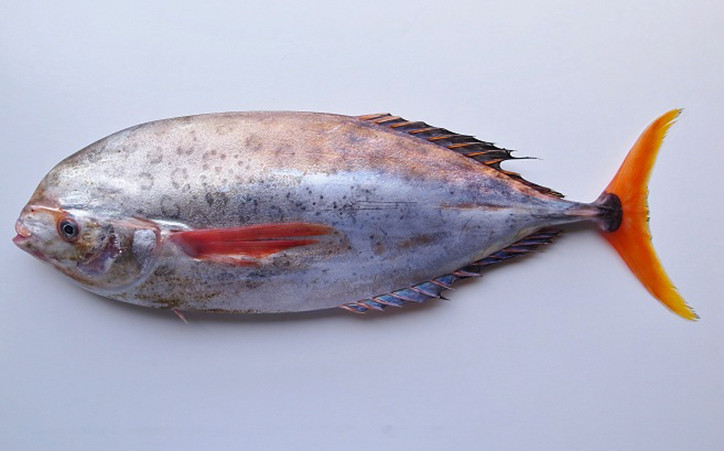
(Luvar. Photo © armacao.exblog.jp)
It is a marine pelagic solitary species. It inhabits the depths of up to 200 meters. The maximum recorded length is 200 cm, specimens up to 150 cm long are more common. The maximum weight is 150 kilograms. It feeds on jellyfish, ctenophores and other gelatinous planktonic organisms. It is a rare inhabitant of the Adriatic Sea.
Representatives of the rabbitfishes or spinefoots (Siganidae) family, comprising 29 fish species, are frequent inhabitants of coral reefs in the tropical zone of the Pacific and Indian oceans. There are thin sharp spines containing venom in the dorsal fin. Pricking at them can be very painful. They are mostly herbivorous pelagic fish. Two representatives of the family are found in the Adriatic Sea:
Dusky spinefoot (Siganus luridus).

(Dusky spinefoot. Photo by © J.E Randall. fishbase.org)
It inhabits the depth of 2-40 meters. It dwells near a sandy and rocky bottom. The maximum recorded length is 30 cm, specimens up to 20 cm long are more common. It feeds on algae. It entered the Mediterranean Sea through the Suez Canal. It is a rare inhabitant of the Adriatic, it has recently been more common.
Marbled spinefoot (Siganus rivulatus).
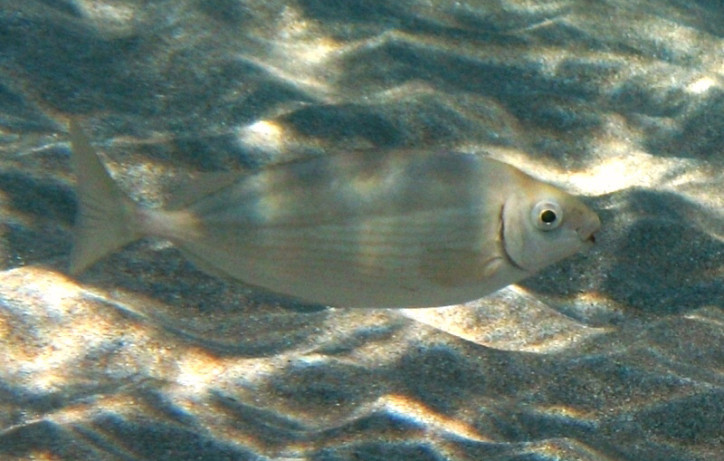
(Marbled spinefoot. Photo by © Roberto Pillon. fishbase.org)
It inhabits the depth of 2-40 meters. It is a schooling fish. The maximum recorded length is 27 cm, specimens up to 20 cm long are more common. It feeds on algae. When a fish is scared, spots appear on its body. It entered the Mediterranean Sea through the Suez Canal. It has been found in the Adriatic Sea several times.
The Cepoloidea superfamily of the Perciformes order comprises only one family. The bandfishes (Cepolidae) family comprises 5 genera and 45 fish species. They inhabit the eastern Atlantic Ocean and the Indo-Pacific region. Most Cepolidae live in burrows, which are dug by them in the oozy and sandy bottom. They feed on zooplankton. One representative of the family is found in the Adriatic Sea:
Red bandfish (Cepola macrophthalma).

(Red bandfish. Photo by © Liam Faisey. cornishkayakangler.weebly.com)
It inhabits the depth of 15-400 meters. It lives in holes that it makes in a sandy or silty bottom. The maximum recorded length is 80 cm, specimens up to 40 cm long are more common. It feeds on zooplankton and crustaceans. It is a permanent inhabitant of the Adriatic Sea.
The small Caproidei suborder of the Perciformes order comprises 18 species of sea fish of 2 genera. They are small inhabitants of the Indian, Atlantic, and Pacific oceans, usually living at depths of more than 50 meters. One representative of the boarfishes (Caproidae) family is found in the Adriatic Sea:
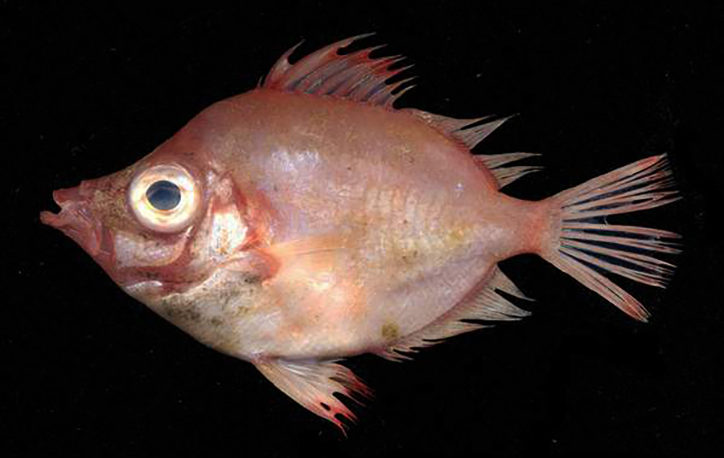
(Boarfish. Photo by © pierlu. naturamediterraneo.com)
It inhabits the depth of 40-700 meters. It is a schooling fish. It dwells near a sandy and rocky bottom. The maximum recorded length is 30 cm, specimens up to 13 cm long are more common. It feeds on crustaceans, worms, and mollusks. It is a permanent rare inhabitant of the southern part of the Adriatic Sea.